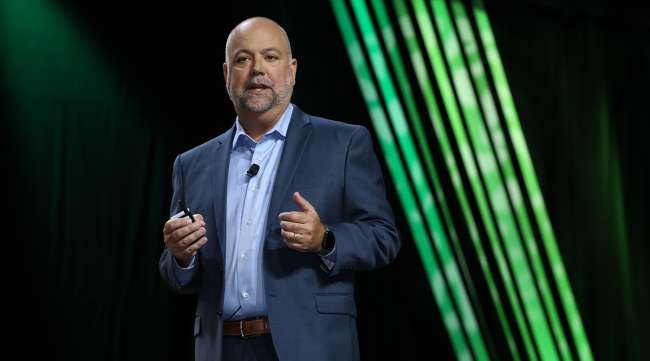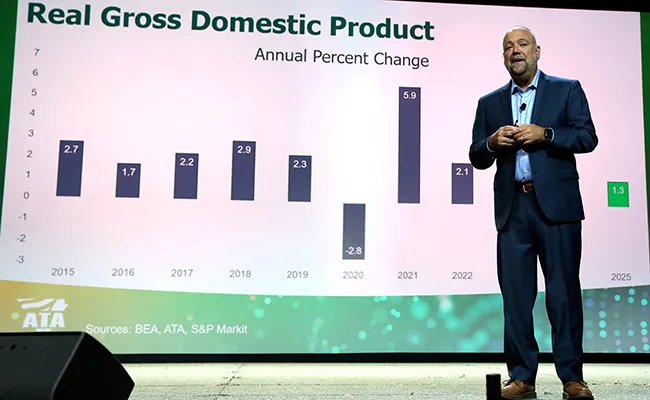Senior Reporter
Mild Recession in 2024 Possible, Costello Says

[Stay on top of transportation news: Get TTNews in your inbox.]
AUSTIN, Texas — American Trucking Associations Chief Economist Bob Costello said the U.S. economy still runs the risk of sliding into a short recession in 2024.
The cautionary note is the result of the delayed reaction from the Federal Reserve’s aggressive increases in interest rates to slow what was a rapid run-up in inflation due to the COVID-19 pandemic and the stimulation of the economy in 2021 and 2022.
Speaking at ATA’s annual Management Conference & Exhibition, Costello said he believes a recession would be relatively mild and that the trucking industry would likely not feel the impact of a contracting economy. That’s because the freight sector already has endured its own downturn in late 2022 and throughout 2023 as consumers shifted from purchasing goods to a more balanced spending pattern of buying goods and services.
“The economy, so far, has avoided a recession,” Costello said. “But understand it takes a full nine months for one rate increase to completely cycle through the economy. So, many of those rate increases that they’ve done since March of 2022, we haven’t seen the impact of them. We still may get a recession here, but it will impact the services side more than the goods side, because we have already been hammered.”
Costello said that in 2021, during the peak of the pandemic, spending on goods increased by 12.2% annually, but it has dropped to a 2% annual increase this year. He anticipates 2024 and 2025 will see an annual 1.3% increase in both years.
Costello said many trucking companies that purchased expensive, often used equipment at top dollar during the pandemic to keep up with the surge of freight on the spot contract market may be in serious jeopardy next year. Rates in the spot sector have plunged and those companies may owe tens of thousands of dollars on their trucks. Much of the freight has shifted exclusively to contracts, leaving these companies without enough freight.

Costello notes that Mexico and Canada are playing a greater role in imports than before. (John Sommers II for Transport Topics)
“The people, fleets that bought that equipment, wow, that is a tough place to be. And this is leading to show you there will be more folks going out of business,” Costello said. “We know that there a bunch of fleets out there, that operate in the spot market that are under a lot of pressure, cost pressure as well as market pressure.”
He pointed out the cost of used equipment has fallen 40% since the peak in 2022, and spot market rates are down nearly 31% in that same time period. Contract truckload average rates per mile have dipped, but substantially less at 6.7% since 2022.
Costello said there are some bright spots in the economy that are beginning to become noteworthy, long-term trends that include North American trade with Mexico and Canada. Mexico has now surpassed China as the nation’s No. 1 trading partner, at an estimated $69 billion per month in May, compared with China’s $47 billion.
He said much of the change has to do with the increasing move by manufacturers to “nearshore” factories and plants closer to the U.S. It reflects years of declining relations with Beijing and the fact companies feel transportation costs will be significantly lower moving products from Mexico. He believes this will be good for the trucking industry, especially at critical entry points such as the U.S.-Mexico border crossing at Laredo, Texas.
ATA's Chief Economist Bob Costello served a fresh update for breakfast on the trucking freight market, giving the scoop on key trends, labor market insights, and economic forecasts for 2024 and beyond. #ATAmce23 #trucking pic.twitter.com/1IPcnTdtjK — American Trucking (@TRUCKINGdotORG) October 16, 2023
“We have had two administrations, one Republican and one Democratic, that have pushed these policies and it is showing up. Mexico is continuing to do very well. I am very bullish on this relationship,” he said. “Canada is almost surpassing China now in terms of where we get our imports.”
Truck crossings between the U.S. and Mexico, Costello said, are up 3.3% year-over-over and crossings at Laredo are up more than 14% during the last 18 months.
“I think this is going to be the gift that keeps on giving, as we see more nearshoring and reshoring in the years ahead,” he added.
With regard to inflation, Costello said the Federal Reserve’s interest rate hikes are slowing the significant increases consumers were seeing at grocery stores, car dealerships and at the gas pump as year-over-year inflation has fallen from more than 9% annually to 3.7% now.
Trimble CEO Rob Painter discusses the company’s continued investment in the freight transportation industry and its vision for a more connected supply chain. Tune in above or by going to RoadSigns.ttnews.com.
Costello said the Federal Reserve has recently moved away from a “hard” 2% target on inflation to a more flexible “average of 2% over the long run,” and that may give policymakers more latitude when it comes to trying to manage the overall economy and keeping prices on a downward trend.
“I think we are ultimately going to settle out at a higher level of inflation than we had been used to, somewhere between 2.5% and maybe more than 3%,” Costello said. That’s because in the last year wages across all sectors have seen annual increases ranging from 3.5% to more than 7%. That was the case in some recent union contracts, such for UPS, railroad workers and longshore workers. Bringing inflation down to 2%, he said, is not realistic, as wages increased at that level.
“No one expects these workers, including truck drivers, to give back their salary increases,” Costello added.
Want more news? Listen to today's daily briefing below or go here for more info:






